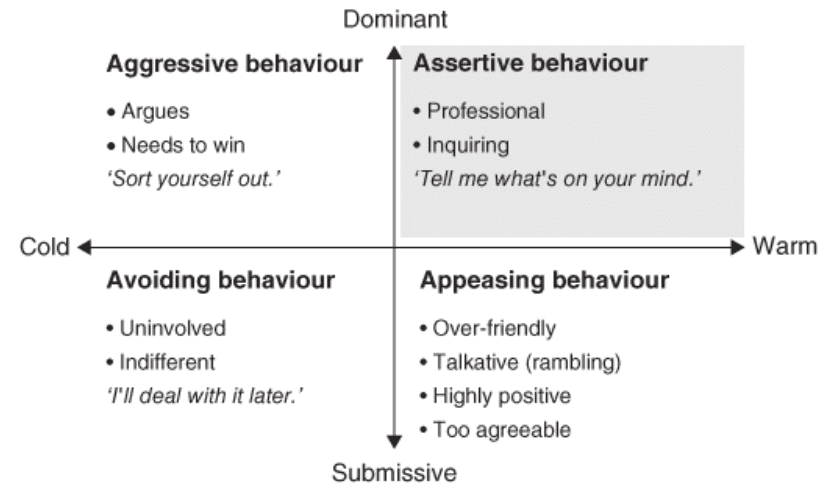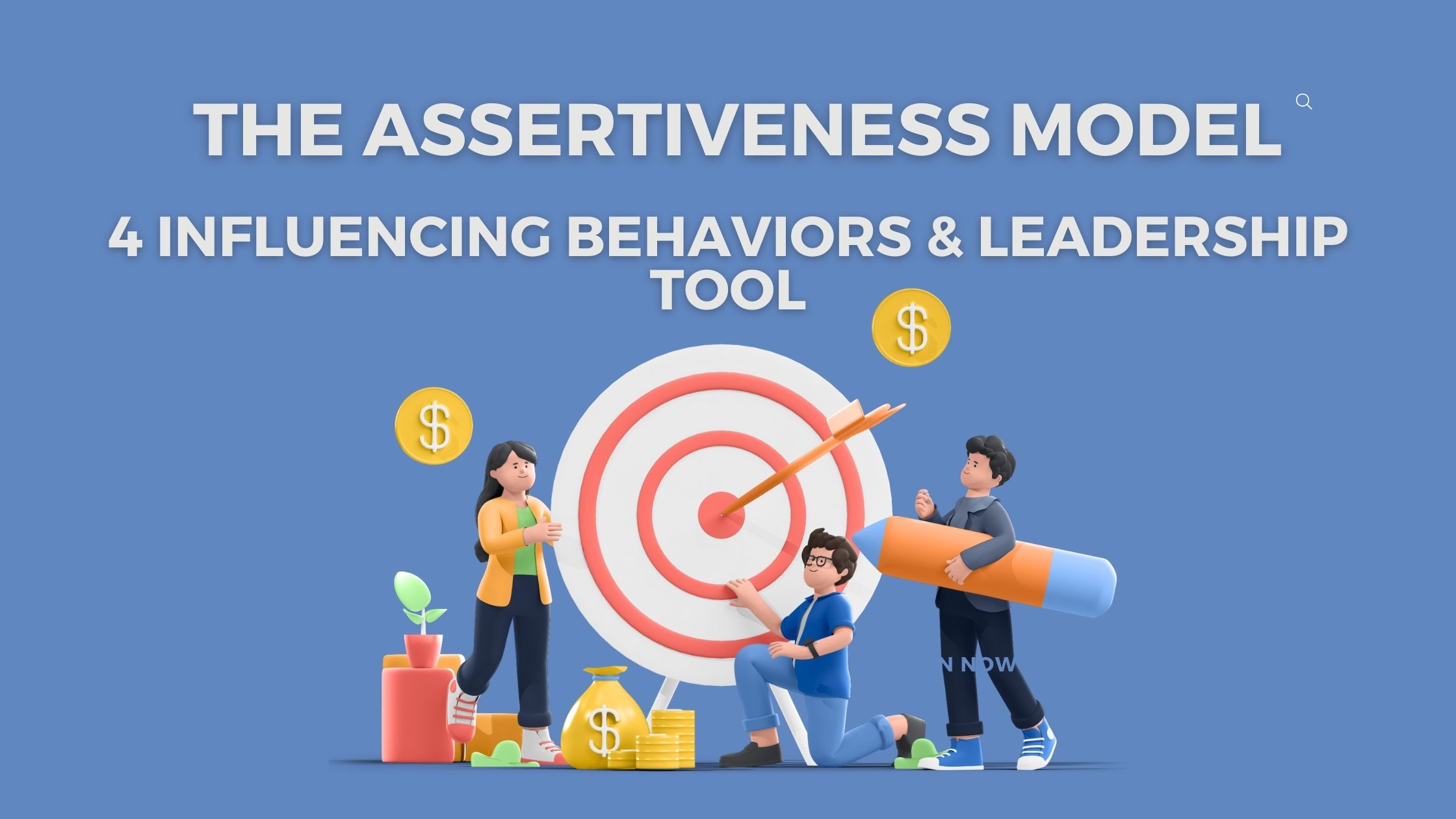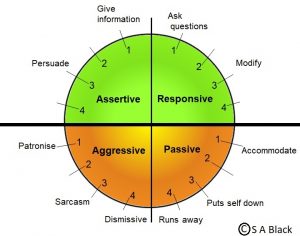The Assertiveness Model is a tool for leading and influencing that helps people find a good middle ground between being quiet and being pushy in social settings. Leaders can use this method to improve their team’s ability to communicate, make decisions, and solve conflicts while keeping confidence and productivity high. Using the principles of the Assertiveness Model can help you be a better leader and create an environment where people can share ideas, build relationships, and meet their goals.

Table of Contents
Assertiveness Model‘s Background
In the ever-changing world of leadership and self-improvement, the ability to influence others via words and actions is of fundamental importance. The Assertiveness Model is a powerful tool for developing leaders who are capable of overcoming obstacles and fostering expansion. This article examines the Assertiveness Model in detail, revealing its relevance in contemporary theories of leadership by exploring its history, components, applicability, limits, and concrete instances.
The Assertiveness Model is a guide for leaders to express themselves confidently while being considerate of others’ feelings and viewpoints. It promotes productive cooperation and conflict resolution by encouraging leaders to avoid either extreme.
The Assertiveness Model is grounded in psychology and communication theory, with critical influences coming from people like Carl Rogers and Abraham Maslow. It was developed as a means for authoritative figures to make their presence felt without being overbearing. The paradigm gained traction as a game-changing strategy that could revolutionise team dynamics, negotiation, and decision-making when leadership dynamics shifted.
Components of the Assertiveness Model
The unique combination of genetics and upbringing that makes up each person’s personality is remarkably stable throughout time according to the assertiveness model. However, conduct is malleable and may be honed and improved over time.
It helps to think about people’s (and your own) actions in terms of whether they are warm or chilly, dominant or submissive.
- Warm: Being warm entails more than just being ‘nice,’ but also supporting, open, positive, empathic, constructive, and engaged.
- Cold: To be cold is to be wary, uncaring, and uninterested in other people and their feelings.
- Dominant: The term “dominant” refers to someone who is assertive, in charge, self-assured, powerful, authoritative, and straight to the point.
- Submissive: To be submissive is to give up one’s independence in favour of another.
Based on the nature, certain leadership behaviours can be observed and identified:
1. Aggressive: dominant and cold behaviour
Effective Responses When Dealing with Aggressive People
Confronting violence might be difficult, but you can change the situation for the better if you prepare properly. Here’s a practical and approachable framework for dealing with hostile behaviour.
- Matching Dominance: When dealing with a dominant person, it’s important to match their level of dominance. If you want to gain the other person’s respect, you shouldn’t be a doormat.
- Choose Assertiveness and Warmth: Pick Assertiveness and Compassion Instead of Coldness and Aggression. Strive for a happy medium by being confident yet coming off as kind and understanding. This method promotes fruitful discussion.
- Open Questions for Understanding: Want to defuse tension? Ask some open-ended questions for better comprehension. You may use open questions as a weapon. Instead of trying to argue your way out of a problem, try asking some questions to open up a dialogue. This lays the door for a more constructive exchange of ideas.
- Harness Body Language and Tone: Use your tone of voice and body language effectively. Convey assurance and aggressiveness via your body language and tone of voice. This not only indicates that you can hold your own against their superior force, but that you care about the result.
Keep in mind that the goal is not to suppress the aggressive behaviour but rather to channel it into action that leads to a positive outcome. By concentrating on them, you’ll be better able to diffuse hostile situations and encourage constructive exchanges.
2. Avoiding: cold and submissive behaviour
Embracing Assertive Leadership: Say Goodbye to Cold and Submissive Behavior!
Leadership that is cold and uninvolved must go. Let’s find the key to confident leadership together with this assertiveness model. How? Read on!
- Engage with Warmth: Rather than being dominant, try being more warm and kind. Make it a place where people feel comfortable sharing their thoughts.
- Pose Open-Ended Questions: These allow for more in-depth conversations. Motivate people to work together and share.
- Soft Body Language: Use kind body language by letting your shoulders down, making gentle eye contact, and flashing a friendly grin. People should feel comfortable approaching you.
- Tune Your Tone: Strike a balance between being confident and domineering in your tone. Like finding the sweet spot in a conversational melody.
To sum up, assertive leadership is a combination of self-assurance and concern for others. Inspire people with your kind leadership and they will follow in your courageous footsteps. Let’s make leadership something that others look up to, respect, and follow. Are you prepared to change? Come on, guys!
3. Appeasing: warm and submissive behaviour
Winning Over the Appeasers: Mastering Warm and Submissive Behavior!
Are you prepared to take a stand against accommodating behaviour? Get ready to learn the ins and outs of how to communicate effectively! The following is a guide that will help you manage these exchanges with ease:
- Stay on Point: Maintain Focus: Make sure to keep the attention directed towards the direction the talk is going. It is essential to gently guide it back in the right direction at all times.
- The Magic of Open Questions: The Power of Open Questions The open-question format allows you to tap into the social side of your audience by asking questions that encourage conversation. However, when things get unclear, you should balance it out by asking straight closed questions.
- Sum It Up: To summarise, the use of summary questions helps to maintain the level of clarity. They will be of assistance in maintaining attention and keeping the conversation on topic.
- Name Game: Playing with Names: Get their attention by using their own name. They are brought back to the topic after a cordial interruption such as this one.
Isn’t it a piece of cake? You are now equipped to win over those appeasers and to make your chats spark with interest thanks to the fact that you have learned these tactics. Let’s make appeasing behaviour a winning strategy by turning it into a winning plan!
4. Assertive: warm and dominant behaviour
Mastering Assertive Leadership: The Perfect Blend of Warmth and Dominance!
Let’s find out how to handle disagreements in a way that makes people want to follow your lead and be more forceful. Finding the sweet spot is crucial:
- Warm It Up: Put some fire into your boldness and Warm It Up. Make a personal connection while maintaining your convictions.
- Thoughts on Convenience: Have you ever pondered the difficulty of assertiveness? Let’s investigate the obstacles and their causes.
- Barrier-Breaking: Delve into the Roots of Our Inability to Speak Up. What’s stopping us from being encouraging and risk-taking?
- Important Queries: Determine the most pressing issues that must be addressed to inspire confident leadership. It’s time to spark transformation.
By taking a confident stance, you’ll be able to resolve problems with ease and impress people with your kind, authoritative demeanour. You’re ready to make a major leap as a leader. Alright, I’m in!
Deep Analysis of Details
Leaders who want to foster an atmosphere where communication and relationships flourish might look to the Assertiveness Model as a compass. Inspiring development, creativity, and teamwork may be yours when you master its ideas and put them into practise as a leader.
Usefulness:
The beauty of the Assertiveness Model lies in its multifaceted utility:
- Enhanced Communication: Leaders armed with this model facilitate open dialogue, ensuring every voice is heard and respected, bolstering the free flow of ideas.
- Conflict Resolution: The model’s warm yet dominant approach fosters constructive conflict resolution, enabling teams to address issues without creating hostile environments.
- Boosted Productivity: By embracing warmth and assertiveness, leaders motivate teams to engage with tasks, fostering a sense of responsibility and commitment.
- Cultivated Confidence: Leaders implementing the model inspire self-assurance in team members, nurturing a positive environment where creativity flourishes.
Limitations:
While the Assertiveness Model empowers leaders, it’s important to acknowledge its limitations:
- Cultural Variation: Cultural norms influence how warmth, dominance, and assertiveness are perceived. What works well in one culture might not resonate in another.
- Overapplication: Overusing assertiveness can unintentionally lead to intimidation. Balancing dominance with empathy is key.
- Complex Scenarios: Certain situations require a tailored approach that might not fit the warmth-dominance model. Flexibility is vital.
Specialty:
What makes the Assertiveness Model truly special:
- Balance and Harmony: It’s a masterclass in balancing warmth and dominance – the perfect recipe for fostering a cohesive and productive environment.
- Adaptability: The model accommodates various leadership styles, adapting to the unique needs of different teams and situations.
- Confidence Booster: By guiding leaders to assert themselves while maintaining empathy, the model fuels personal growth and leadership confidence.
Assertiveness Model‘s Examples
In order to illustrate the relevance of the concept to the actual world, let’s look at two examples:
Corporate Example:
Consider the following scenario in the business world: a CEO is going to use the assertiveness model to lead a diverse staff. The CEO should exude warmth to enable open communication, which will result in all employees feeling appreciated. The confident attitude used by the CEO helps the firm to keep its focus and ensures that decisions are made in an effective manner, which both contribute to the company’s progress towards its goals.
Behavior-Based Example:
Consider the scenario of a project team where different members have different opinions. The forceful style, which is both domineering and frigid, generates conflicts and makes it difficult to collaborate. The team handles problems while simultaneously cultivating unity and making progress as a group by using a forceful approach, which may be described as warmly dominating.
You may use the Assertiveness Model as a guide to help you succeed in the complex world of leadership. It gives you the ability to be dominant and kind, fostering an environment where new ideas may flourish, disagreements can be resolved, and relationships can flourish. Remember that leadership is more than simply directing others; it’s about motivating them to achieve their full potential when you use this framework. Prepare to make a difference as a leader and propel your team to success.
Resources
A Model of Assertiveness for Purposeful Conservation
How to Develop Influence and Assertive Leadership!
Find out more tools here which one do you need in tools and techniques?
References


